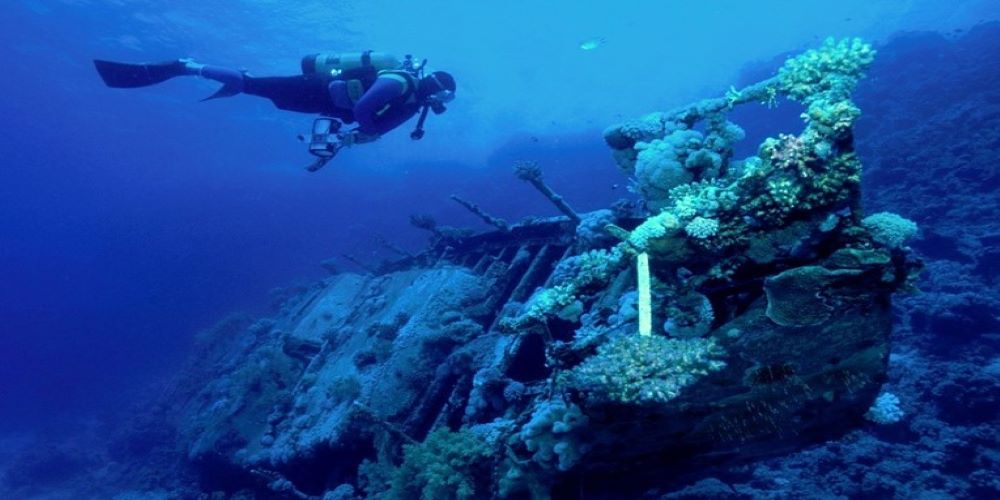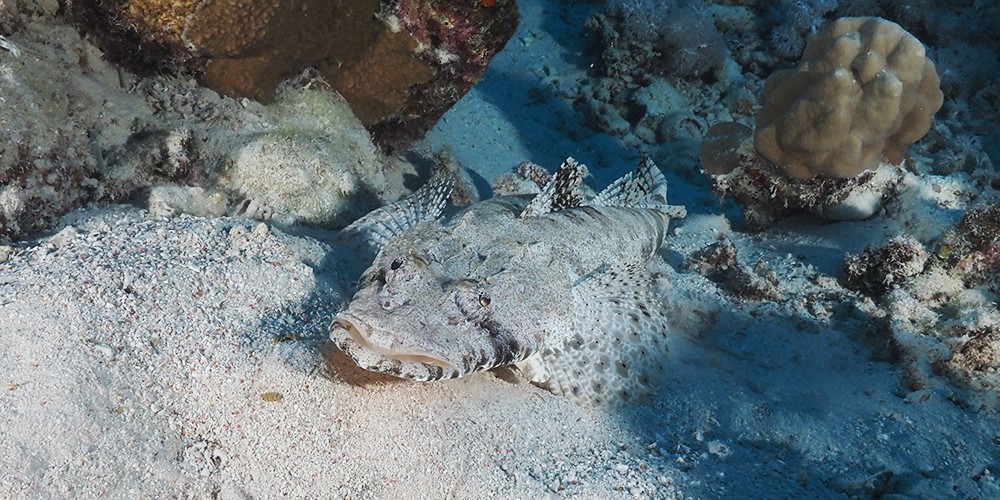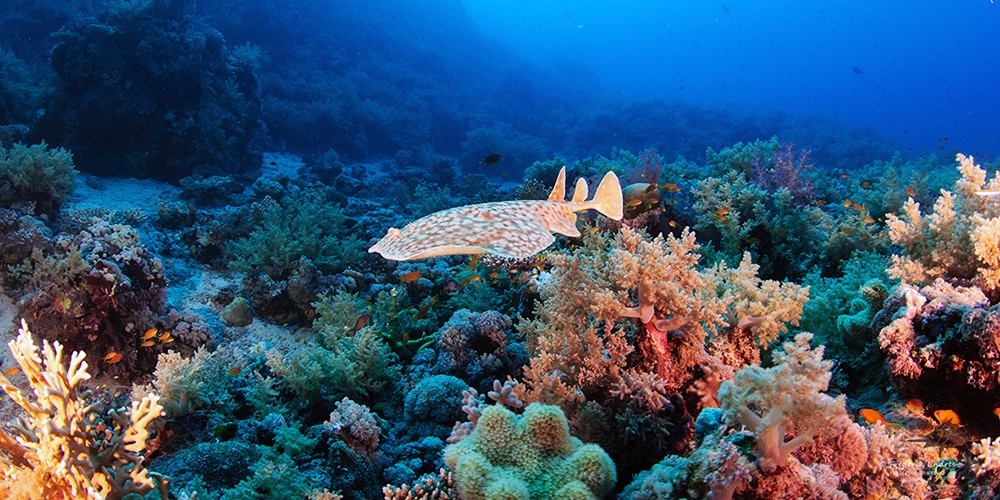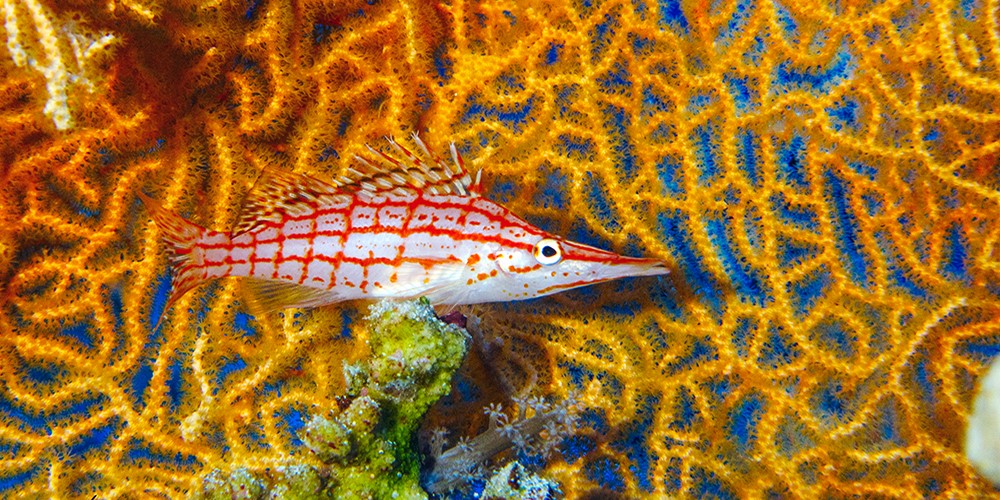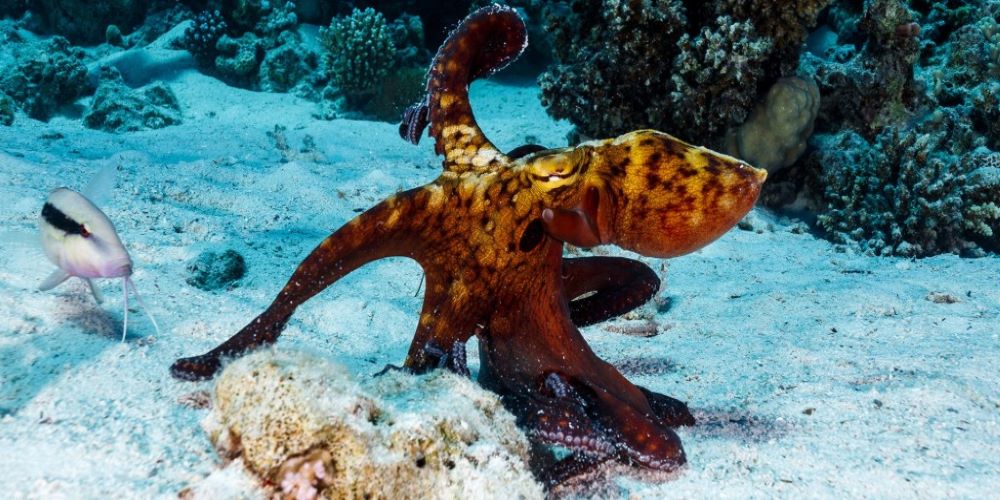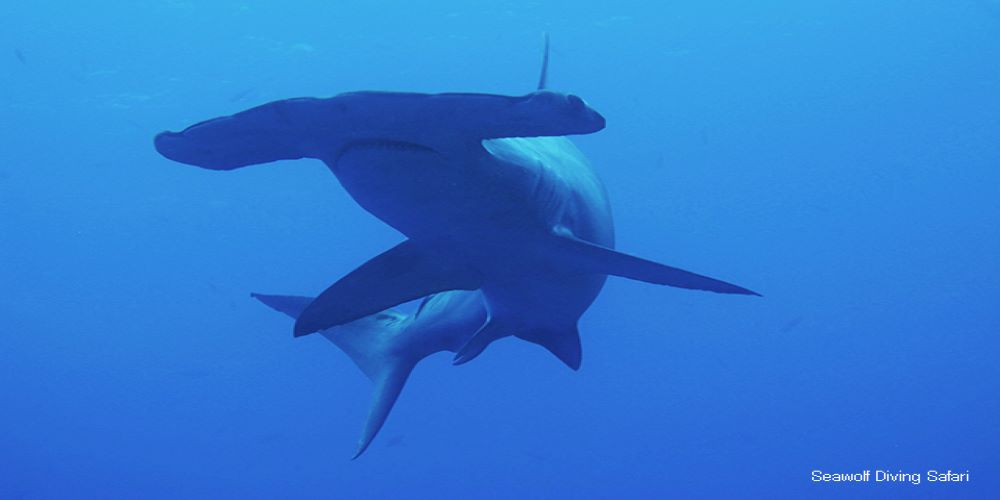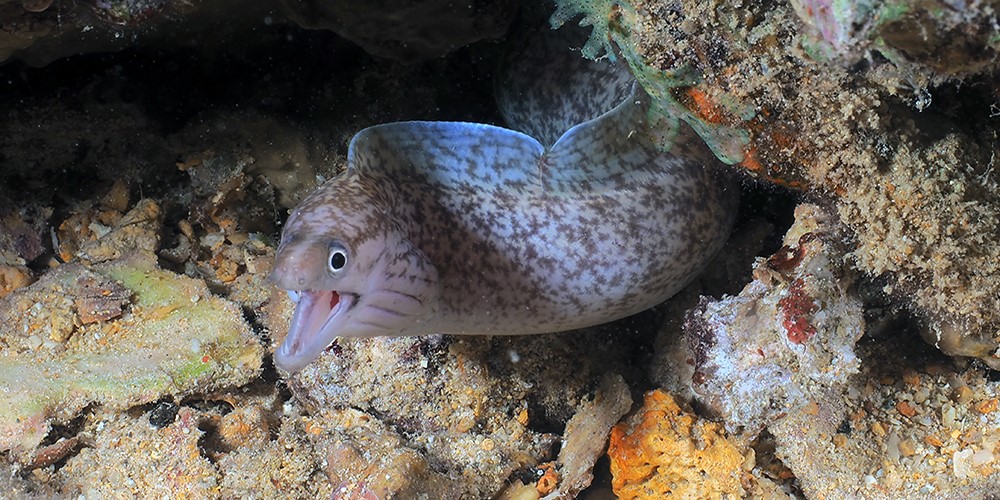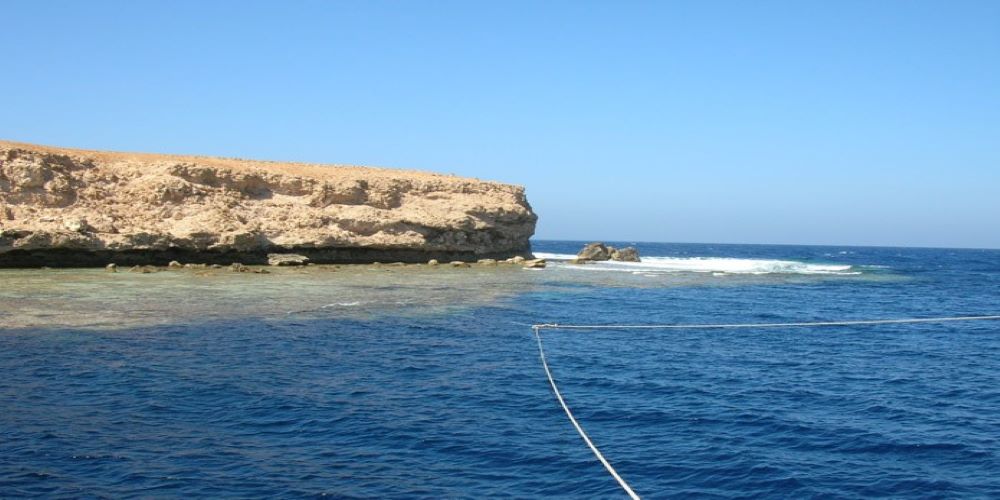MP South (Daedalus/Zabargad/Rocky Island)
- Daedalus - Zabargad - Rocky Island
- The Marine Park South Tour starts from Port Ghaleb - after 2 dives we head directly south to Daedalus Reef. The striking lighthouse of Daedalus can be seen from far away. The reef extends over a length of more than 1.2 km. Steep wall diving in the regular current and shark encounters characterise the dives around Daedalus.
- Now it's on to the reefs of Zabargad and Rocky Island, the islands furthest south in the Egyptian Red Sea. Countless soft and hard corals await divers here in the deep south. On the way back we visit the sites of Sataya, Malahi, Abu Diab, Shaab Maksur, Shaab Claudia, Abu Galawa and Gota Sharm, so there is plenty of variety! Shark encounters also await you here with great regularity - only about half a dozen safari boats go to these far southern reefs.
- Before we return to Port Ghaleb, Elphinstone Reef is another treat! The northern tip offers the best conditions to meet some hammerhead sharks on an "early morning" dive.
Expect to see
Elphinstone
From Marsa Alam the boat goes about one and a half hours north to Elphinstone Reef! The reef top of Elphinstone Reef lies at a depth of between one and three meters, depending on the water level. Strong surface currents and lots of boat traffic make snorkeling here impossible.
Divers, however, can dive right into a challenging treat! The reef is known for its exceptional biodiversity and, of course, sightings of large fish. In the north we dive on a sloping plateau from 18 to 40 meters and in the south on the underwater terraces. The west and east walls drop off steeply into the depths. The Elphinstone reef has a total length of about 600 meters and a width of 70 meters.
In large numbers we can see hard and soft corals in all colors. In addition, there are turtles, moray eels, loceanic white tip sharks, hammerhead sharks and pretty much everything that the Red Sea has to offer.
Daedalus
With a length of 600 to 750m and a width of 100m in the north and 300m in the south, Daedalus is a very large reef. In the south there is a lighthouse that guides the ships at night. Here you can shop, stretch your feet or climb the lighthouse. On the north side there is a steep wall, which towards the east on a depth between 18 and 40m changes into several lagoon like plateaus. There in the blue water you can find the hammerhead sharks. Usually, depending on the current, several groups of 12 to 25 animals each can be found.
Almost all boats anchored at Daedalus will send their Zodiacs north in the early morning hours. The best place to go in the water is at the northwest corner.
It is worth - always in sight of the reef - to dive a bit into the blue water and just wait at 20 or 25 meters depth. If there is nothing to be seen, dive calmly at the same depth in southeast direction around the reef top. On the east side there are two lagoons, near which the hammerhead sharks usually come out of the depth. At the first moment you will usually see only one animal. It will dive past you at some distance and lie down on its side to show its strength. Stay where you are. Do not go deeper or follow the shark - it will disappear into the depths. However, if you have waited patiently, the other animals in the group will come out of the depths and attempt to get close to you. If you get too close to them, they will dive away. But if you stay where you are, or even ascend a few meters - yes, yes, the NDL time - the animals will usually follow. Then you have the opportunity to enjoy this spectacle for up to 20 minutes.
Nearby is also the so called "Manta Point" with its colorful reef wall. The whole east side is a first class spot. You should always look below you into the depth or into the blue water - there will always be big hunters in sight.
The west side with its notches is home to one of the largest anemone colonies in the Red Sea. More than 200, with their red outer shell and delicate yellow to greenish coloring, have attached themselves to the reef on a width of just 10 meters in the narrowest of spaces. This colony reaches down to a depth of more than 50m. But further south it finally takes your breath away. There sits a gigantic hard coral, at whose sight one feels tiny: Like a waterfall it falls down from 4 to 19m. Unfortunately, the first damages are already visible.
In the south of Daedalus there is a plateau with big and small boulders - a good place for the thresher shark. Nearby is rubble and steel from the lighthouse. Moray eels and groupers slumber in it. You can also find turtles, gray reef sharks, hunting mackerel and tuna, and of course stonefish and snails.
At the southern drop-off edge of the plateau you can find a small colony of anemones. The special thing about it is the coexistence of different colored species in a small area. In the upper area one often encounters deep sea sharks, such as the Oceanic white tip shark and the silky shark.
Daedalus is also an outer reef and marine park. Apart from the general regulations, anyone going diving here should be able to cope with changing, sometimes strong currents, high waves and Zodiacs. In addition, a deep dive specialty is recommended.
Shaab Sharm/Gota Sharm
Gota Sharm has a length of 250m, a width of 100m and runs in a wedge shape from west to east. There are plateaus at both ends. The rest consists of steep walls that reach more than 100m into the depth. The plateaus are 20m (close to the main reef) to 35m deep (in the outer area). The current usually comes from the northwest in the morning and from the north at noon. Despite this predictability, you should pay attention to it, because it can get very strong and you run the risk of being blown off the plateau.
On the eastern plateau you can find the longnosehawkfish in a gorgonian, lionfish under table corals, barracudas, reef sharks, schooling fish and two cleaning stations: one in the middle of the plateau for young tuna, the other, by a large block on the south side, for surgeonfish.
On the east plateau, the current can cause turbulence that makes diving difficult.
The western plateau is narrower than the eastern one and there is also a cleaning station here. On its northern side the current usually meets Gota Sharm. So a good place for big fish like the hammerhead shark. Pretty much opposite, on the south side, manta rays have been spotted, but it is more likely to encounter reef sharks, mackerels, tuna and barracuda.
Abu Galawa Kebir
At Abu Galawa Kebir there are lagoons and several side reefs that offer everything there is to see in the Red Sea. Blue staghorn corals, wonderful landscapes.
Besides the "Rosalie Moller" and the "Numidia", the steam tugboat of Abu Galawa, the "Tien Hsing", is one of the most beautiful shipwrecks in the Red Sea. She was a harbor tug built in Shanghai in 1935. With a length of 36m, a beam of just over 7m and a draft of about 3m, it was a rather small ship for these purposes. On October 26, 1943, the tug sank and now lies at a depth of 12-13m in a slight angle on the west side behind the canal.
The wreck is easily visible on the starboard side, but less so on the port side, so many corals grow on it!
The coral garden on the west side consists of mountain corals. In the upper part, the cuts and channels are overgrown with table corals. Also here you can dive great at night.
Abu Galawa Soraya
A sailing yacht from the USA sank at "Abu Galawa Soraya" in 1980 and has since been colonized by very many soft and hard corals. An incredible sight in 17 meters depth on a length of 15 meters. But not only the great overgrown wreck convinces here.
Needlefish, blue spotted stingrays, red sea fusiliers and free swimming giant moray eels can be spotted and admired at this dive spot with a little luck. What will please many - "Abu Galawa Soraya" is also suitable for a night dive and what better way to see the various wreck dwellers than at night!
Equipped with light we can see inside the wreck also during the day the many glass fish that have made the yacht their own for a long time. Also on the sandy bottom many surprises are waiting between the coral towers and blocks.
Sataya Gota Soraya
"Soraya" means "small". This tells us that we are on the sister reef of the larger Sataya Gota Kebir. The water depth in the area to be dived is 20 to 25 meters. The reef has a length of 250m and a width of about 70m. The boat usually moors in a small lagoon in the southeast of the reef. However, depending on the current, there is also the possibility to moor the boat in the southwest at a notch of the reef. The Sataya area almost always has current from the north.
The mooring in the southeast, in the lagoon, is also one of the most beautiful places to dive in the midday. Very few people dive here and you get the impression that you are entering the water shortly after the coral garden is formed.
The most common diving tours, due to the current from the north, start with the Zodiac of course in the north. Then one has the free choice whether one dives left or right hand side. Here you can practice navigation and you have a dive of about 60 to 70 minutes in each direction. There is also a small path in the north through a cave into a lagoon. This is covered with mountain corals. The whole area is full of huge mountain corals, large table corals, leather corals and soft corals. There are a lot of juvenile fish, large schools of snappers, bigeyes and barbels. You can also find snails, as well as dolphins and young reef sharks.
There is another coral garden in the northwestern area, behind a sandy road. It consists of old and new coral formations and slopes down to 40m in the north.
Shaab Claude
Shaab Claude is about 150m long and 60m wide with a maximum depth of 24m. Boats usually anchor in the south, because there is the cave entrance in 10m depth. Also most of the fish can be found in the southern part of the reef. Here live e.g. batfish, triggerfish, bannerfish, barbels and snappers. Also big napoleon wrasse are not rare.
Often a current from the north makes diving on the west side above the coral garden difficult or impossible. After a bumpy ride by Zodiac to the channel and the anemone colonies, you will be rewarded with a nice drift dive on the east or west side.
Shaab Maksur
It is 350 to 400m long and has three plateaus, one of them - untypical for an outer reef - on the west side. The currents are similar to Elphinstone, as both reefs have almost exactly the same orientation.
The south plateau actually consists of two levels. The first ranges from 18 to 35m, the second from 35 to 42m. Both have a length of 50 to 60m and a width of 40m. At the end, the reef descends steeply to 80m, then continues into a slope to 120m before disappearing fully into the depths.
The west side has something special, because bordered by a coral garden and a block at the end there is a small lagoon in the middle of the plateau, which is very nicely embedded with a depth of 13-16m and a width of 20m. Here lie some pieces from an old safari boat that hit the reef after 14 days in service. The riggings were thrown overboard and the hull was taken to the shipyard for reconstruction. Meanwhile the reef has grown very nicely around the wreckage.
The eastern area is a drop off and to the north there is another plateau at a depth of 20 to 37 meters where there are smaller mounds and a coral garden. Here, as everywhere on this reef, downward currents can occur. At the northernmost point there are two more rocky pinnacles separated from the reef by an 8m deep gap.
Sheleniat
The reef has a width of 150m and a length of 200m. With a depth of 16m it belongs to the very shallow dive sites. The corals here are mostly only 50cm high. The 2 to 4m high hills are the optimal area for damselfish.
On the west side there are two big lagoons, which are connected inside at 6m depth. They are overgrown with stag and mountain corals. On the sandy bottom you will find gobies and crabs living there symbiotically.
The north is bordered by a long block. On the west side, on the other hand, there are four coral mounds from 2 to 8m high.
The east side has an elongated reef wall with single fields of mountain corals and in the outer area isolated 2m high towers. The variety of corals and fish here is indescribable!
To the south are individual lagoons and ancient coral that is home to batfish, large groupers and moray eels.
This is a good night mooring and night diving site.
Around the hills the current often changes and forms swirls.
Shaab Malahi
Shaab Malahi has a length of 100m and a width of 60m. The depth varies from 22m to 6m in the inner area. Only on the east side after about 50m there is a drop-off edge.
The reef is a maze of boulders that enclose the area in an almost circular fashion. Some of them rise 16 to 20m steeply and in the upper area an overhang has formed.
The labyrinth of blocks is most relaxed to dive with a guide, moreover, the diving depth varies often and sometimes extremely, so that the ears have to give maximum performance here.
Shaab Malahi gives you the opportunity to observe the formation of reefs, because due to the weather this reef is always in motion. Here you should watch out for falling objects in the overgrown corridors and caves.
Behind and below the boat is a sandy area that hosts some nice big boulders at about 20 meters depth, running far to the south. To its southeast are two blocks that look like they are connected to table coral. Here and a little further north there are schools of banner fish. But there is a lot to discover in this area in general.
Erg Abu Diab
This spot is typical of the biodiversity of the southern Red Sea, but also known for encounters with large sharks. Often the diver meets groups of hammerhead sharks. But also the encounter with gray sharks and thresher sharks is likely here and with good luck among them also an oceanic white tip shark.
Zabargad
Zabargad has two shipwrecks to offer, both in the sport diver friendly area. On the east side, between 1 - 24 meters deep, you will find a wreck 70 meters long and about 10 meters wide, the name and history of which have long been the subject of speculation. It is assumed that it is a Russian motor freighter that sought the protection of the island after a collision or explosion on board and sank there - the damage in the stern area would speak for this. The vegetation of the wreck suggests a sinking period in the 1950s to -60s.
On the southeast side, there are many cave passages in the upper reef area where, if you are lucky, you can find nudibranchs and turbellaria. On the west side of Zabargad, besides beautiful hard coral gardens, you can dive the remains of the safari ship "Neptuna", which sank here in 1981. On the sandy bottom at a depth of 24 meters you can find evidence of the sinking: a generator, several suitcases, a radar unit and a diving tank. However, there is no trace of the wreck of the ship. Since the reef is only slowly steepening at this point, the safari boat cannot have slipped any further into the depths, so it must be lying somewhere nearby. Presumably, at that time, when the stern was already submerged, it drifted a little further, while the mentioned objects fell overboard. The wreck of the "Neptuna" could not be located until today and thus remains one of those mysteries with which the Red Sea can still come up with.
Safari boats usually seek shelter to anchor on the south side of the island - behind a large lagoon. Around the lagoon, which is about 10-12 meters deep, it descends steeply to depths of over 50 meters. You can reach the inside of the lagoon through numerous passages through the rock that rises around the lagoon and is lush with colorful soft corals.
Rocky Island
The island has an extension of 300m by 80m and has a fringing reef all around.
The south side of the reef consists of overhangs and half caves where very often white tip reef sharks sleep. Even more, the east and west are real Shark Points, because here the sharks are in a current that comes from the north and also brings in huge schools of sardines and their predator, the tunas.
The north, on the other hand, is a deeply indented steep wall with ledges and overhangs. Here one sometimes encounters dolphins.
Around Rocky Island again marine park rules apply and due to various currents it is a very challenging reef.
Itinerary
ATTENTION: The tour description is only a suggestion. Which dive sites are dived on the tour depends on many factors, including wind and weather.
Arrival
After arrival in Hurghada or Marsa Alam transfer to the boat.
Check in, dinner and spending the first night onboard in the marina.
Departure
Departure in the morning.
Familiarization of the boat,
Diving, safety and equipment briefing.
Dives at Abu Dabab
Daedalus
3 dives at Daedalus
Daedalus
3 dives at Daedalus
Rocky Island
Dives at
Rocky Island and Zabargad
Sataya
Dive at
Sataya
Shaab Claude
Abu Galawa Soraya
Night dive at Gota Bohar
Return
Dive at Elphinstone reef and Abu Dabab
Return to the port.
For safety reasons you should not dive 24 hours before your flight home.
Check out
Breakfast and check out no later than 10:00 am.
Transfer to the airport or hotel.

 ENGLISH
ENGLISH
 РУССКИЙ
РУССКИЙ
 DEUTSCH
DEUTSCH

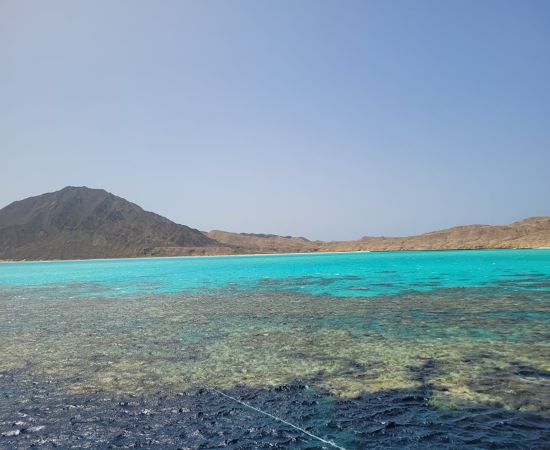
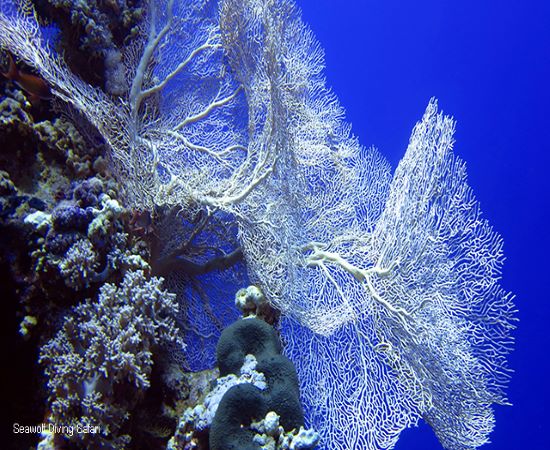
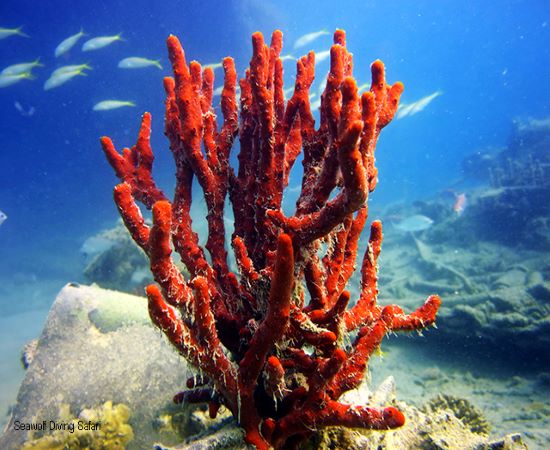

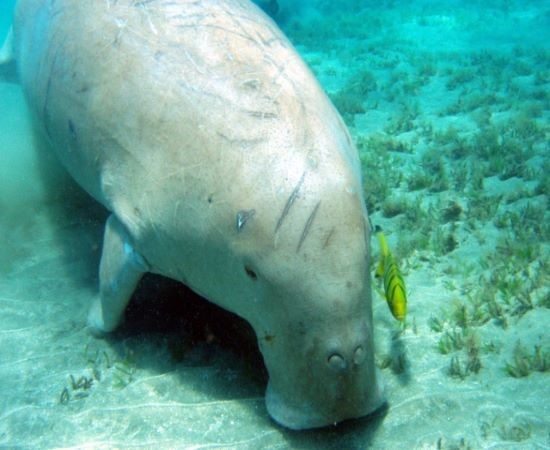
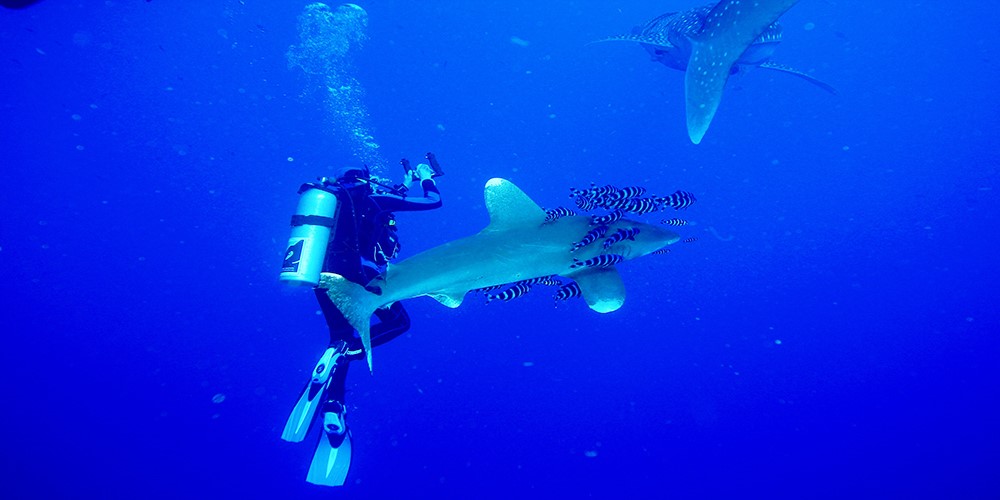
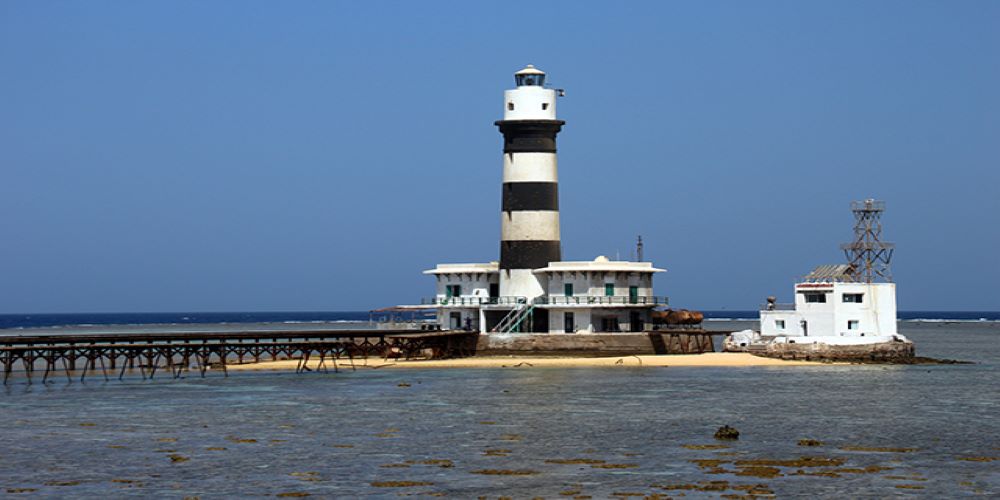
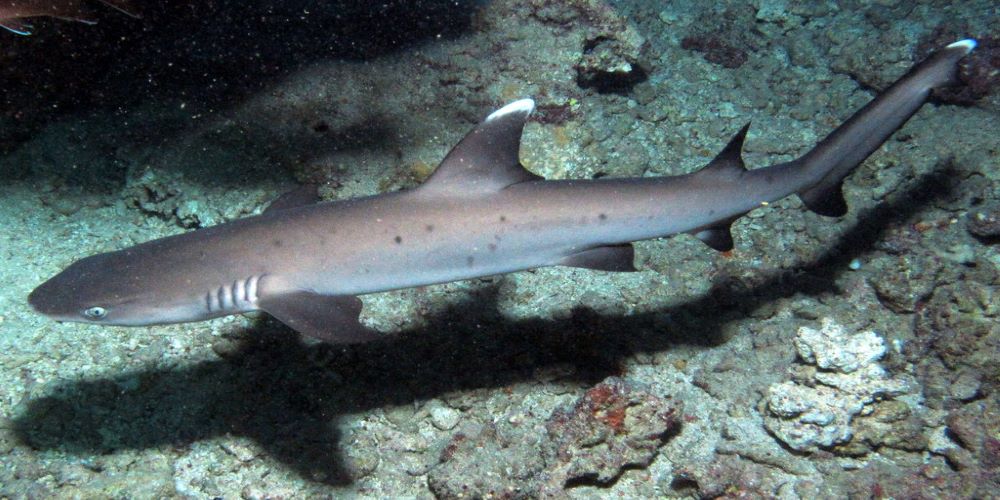
_lg.jpg)
